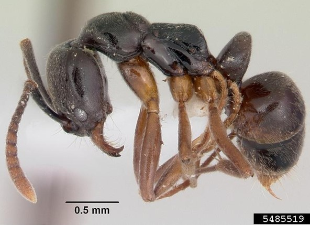



Photographer: Eli Sarnat Affiliation: Antkey, USDA APHIS PPQ, Source: Bugwood.org Copyright: (CC BY N-C 3.0)
Asian needle ants are medium-sized ants, typically measuring between 1/8 to 1/4 inch in length. They are smaller than carpenter ants but larger than sugar ants. They have a slender, dark brown to black body with a distinctive, smooth appearance. They have very notable, long and sharp mandibles, which they use for both defense and foraging; and a characteristically prominent stinger that protrudes from the lower, rear abdomen.
The Asian needle ant poses several threats to humans. First, its venomous sting is painful, and can be more likely to cause an allergic reaction than a honey bee’s sting. *People allergic to insect stings should take special care to avoid stings when in an Asian needle ant-infested area. *
Second, is its ability to infest natural and urban areas homes. Since their colonies are much smaller in population size, they can go unnoticed until they’re found scavenging food from trash bins or kitchens. While ants crawling on food is a nuisance, the main threat is the increased risk of people being stung.
The third, and potentially greatest, negative impact posed is the Asian needle ant’s potential to devastate natural environments by excluding native ant species and termites. Our native ants play essential roles in maintaining the status quo of the forest ecosystem and Asian needle ants either directly eat them, consume their food, or take over their nest sites. When the Asian needle ant eliminates or reduces the abundance of native species, the balance of ecosystem is negatively affected because it interferes with organic matter decomposition, pollinator efficacy, and plant seed dispersal.
Colony populations range from hundreds up to a thousand individuals which is smaller than other invasive ant colonies like the Red Imported Fire Ant. As their invasive range suggests, the ANA are relatively cold tolerant, which allows them to emerge earlier in the spring and have a competitive advantage over other ants. Furthermore, the occupation of mountainous regions suggests their ability to survive harsh winters. Since ANAs are predatory opportunists, their colonies can be found near termites or other ant species' colonies.
The Asian Needle Ant was first discovered in 1932 within 3 different states but was not labeled as an invasive pest until 2006. The delay in pest-status is partly because it is not aggressive like invasive Red Imported Fire Ants, has invaded natural or unpopulated habitats unlike the invasive Tawny Crazy Ant or Argentine Ants, and the inconspicuous dark coloration allows to go unnoticed unlike invasive Pharaoh Ants. The Asian needle ant can nest in both disturbed and “natural areas” like forests; ranging from school cafeterias to residential lawns to logs in State and National Parks. Over the past few decades, it has been documented in several U.S. States, and it is capable of invading much of North America’s temperate forests.
China, Japan & Korea.
Habitat: The Asian needle ant seems to prefer termites as a food source but will scavenge on a variety of arthropods and other invertebrates such as crane flies, crickets, cockroaches, beetles, spiders, centipedes, earth worms, etc. It thrives in temperate climates and unlike other invasive ants, the Asian needle ants are capable of invading undisturbed forest areas where they nest under and within logs and other debris, under stones, and in leaf litter. They also occur in residential and urban areas under landscaping items like mulch, pavers, timbers, and other objects; or find sugar sources like fruits, jellies, or other foods from human trash bins.
U.S. Present: AL, AR, CT, FL, KY, GA, MA, MD, MS, NC, NY, OH, PA, RI, SC, TN, VA, and WI. If you believe you see one, please email a picture of the animal and its location to invasives@shsu.edu.
Texas: UNVERIFIED report from a museum specimen in Victoria, TX.
Due to their generic dark coloration, Asian needle ants resemble many ant species including other pests like the common odorous house ant (Tapinoma sessile) and the invasive Argentine Ants (Linepithema humile). The invasive needle ants can be separated from those species by:
However, there is a behavioral trait that can help distinguish the invasive ANA as they are unable to cling to smooth surfaces like glass. If you capture an ant in a glass jar and you see an ant with a large-stinger unsuccessfully trying to climb the jar- this would suggest you have an invasive Asian needle ant.
In areas where this species has been present for decades, it is important to think of managing these ants versus fully eradicating them from your area.
Chemical: Currently, there is no formal management protocol but since they will scavenge on invertebrate carrion, they are attracted to protein-based insecticide baits. Professional products such as Extinguish Plus®, Advion® Fire Ant Bait, Optigard® and Maxforce FG® are suitable baits for this pest. For homeowners, some of the fire ant baits such as “Amdro”, should work. Starting your treatments in April (IF ant activity is observed) may help reduce the impact of baiting on non-target ant species.
Text References
Bertelsmeier, C.; Guénard, B., Courchamp, F. 2013. Climate change may boost the invasion of the Asian needle ant. PLoS ONE. 8: e75438. https://doi.org/10.1371/journal.pone.0075438.
Guénard, B.; Weiser, M.; Gomez, K. [and others]. 2017. The Global Ant Biodiversity Informatics (GABI) database: a synthesis of ant species geographic distributions. Myrmecological News. 24: 83-89.
Leath, T.M.; Grier, T.J.; Jacobson, R.S.; Fontana-Penn, M.E. 2006. Anaphylaxis to Pachycondyla chinensis. Journal of Allergy and Clinical Immunology. 117:S129. https://doi.org/10.1016/j.jaci.2005.12.517.
Rodriguez-Cabal, M.A.; Stuble, K.L.; Guenard, B. [and others]. 2012. Disruption of ant-seed dispersal mutualisms by the invasive Asian needle ant (Pachycondyla chinensis). Biological Invasions. 14: 557-565. https://doi.org/10.1007/s10530-011-0097-5.
Smith, M.R. 1934. Ponerine ants of the genus Euponera in the United States. Annals of the Entomological Society of America. 27: 557-564. https://doi.org/10.1093/aesa/27.4.557.
Vogt, J.T. 2021. Asian needle ant. Science Update SRS-SU-143. Asheville, NC: U.S. Department of Agriculture Forest Service, Southern Research Station. 2 p. https://doi.org/10.2737/SRS-SU-143.
https://www.purdue.edu/fnr/extension/wp-content/uploads/2022/05/asian-needle-ant.pdf
Internet Sources
https://antmaps.org/?mode=species&species=Brachyponera.chinensis
https://www.srs.fs.usda.gov/pubs/su/su_srs143.pdf
https://www.orkin.com/pests/ants/asian-needle-ant
https://entomology.ces.ncsu.edu/asian-needle-ant/
https://www.purdue.edu/fnr/extension/first-report-of-the-invasive-asian-needle-ant-in-indiana/